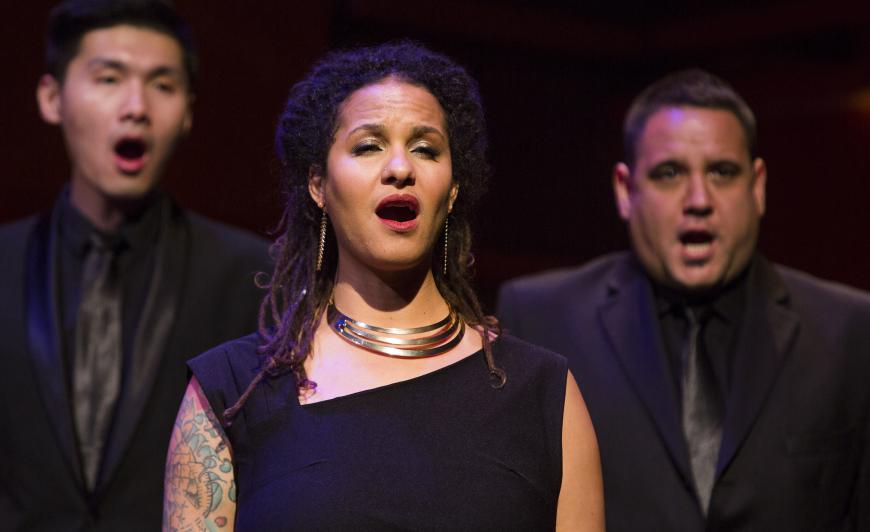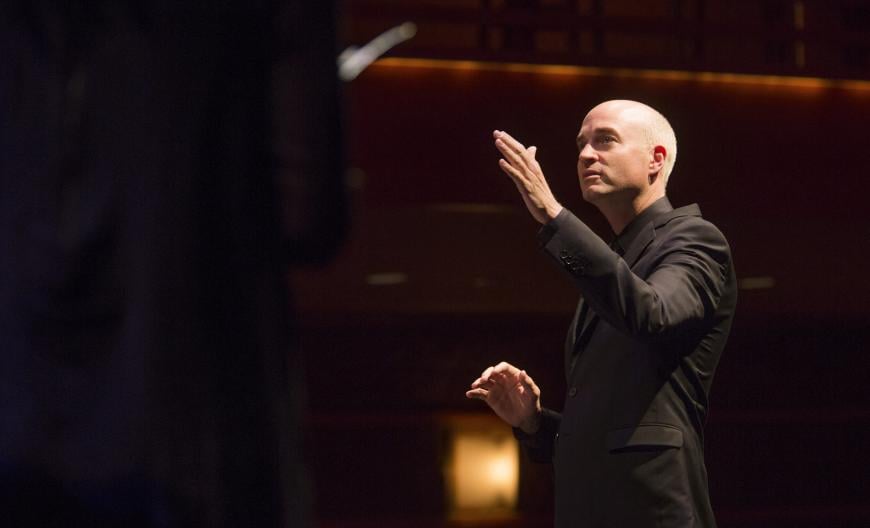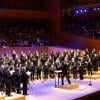
At the heart of “To the Hands,” Pacific Chorale’s season-opening program based on Caroline Shaw’s 2016 work of the same name, is the idea of effecting change and empowering people to help others. Conductor and Artistic Director Robert Istad is facing questions about the purpose and efficacy of art head-on in this special choral-theatrical concert.
Directed by Marty Austin Lamar, the production — incorporating dance, projections, and what Istad refers to as a “musical collage” of works from Dieterich Buxtehude to Sarah McLachlan — is coming to the Samueli Theater at Segerstrom Center for the Arts on Sept. 14 and 15. Pacific Chorale has partnered with the OC Food Bank to encourage concertgoers to bring donations, and as Istad proudly told SF Classical Voice, the ensemble has already collected hundreds of pounds of food.
This concert is not just a season opener for Istad but an opportunity to start changing the culture of Pacific Chorale. “We’re going to get more involved in mobilizing the over 250 people that sing with us, [having them] be more than performers in our community,” he said. “[This isn’t just a] special and important moment in the artistic development of Pacific Chorale but also in our transformation into a really community-centered organization.”
Shaw’s To the Hands was commissioned by the Philadelphia chamber choir The Crossing for its “Seven Responses” project, a set of pieces mirroring Buxtehude’s cantata cycle Membra Jesu nostri. Each of Buxtehude’s cantatas is devoted to one of seven suffering parts of Jesus’s body during the crucifixion, and Shaw responded to Ad manus, hence To the Hands.
Istad explained that Shaw’s score leans deeply into connecting Christ’s hands with his actions. “She imagines that if Christ were alive and walking the world today, walking the planet, that he would be helping the homeless and refugees and those that are displaced,” he said.
Using a combination of text from the original Ad manus, a reconfiguration of Emma Lazarus’s poem “The New Colossus,” and data from the Internal Displacement Monitoring Centre, Shaw weaves a poignant work that meditates on the breadth of suffering experienced by displaced and disenfranchised people.
On first hearing the work, Istad realized that he wanted to program Shaw’s composition with Buxtehude’s, recognizing Shaw’s piece in particular as worthy of much wider popularity in the choral sphere. “But I’ll tell you, [the piece] just worked its way inside of my heart,” Istad said. “And since I took the job at Pacific Chorale, I [knew that I wanted] to go deeper with this piece.”

Shaw’s work is scored for a 16-voice choir and string quintet — in this performance, members of Delirium Musicum, headed by violinist Etienne Gara. Lamar, the production’s director, has an impressively broad background as a vocalist, composer, director, and actor. And in his job at Metropolitan A.M.E. Church in Washington, D.C., he also “lives a very deep spiritual life,” Istad said, making Lamar uniquely qualified for this project.
“What I really appreciate about Marty is that he is calling the singers in to have an emotional experience, a connected experience with one another and then with the audience,” Istad said. “He himself sees the audience as the real focus of the performance. And so [he’s] devising a concept around bringing an audience into our own emotional vulnerability as singers. I think that’s something that’s completely new in choral music.”
Istad has interleaved the two major pieces on the program with largely unaccompanied arrangements of songs that he believes amplify the message of compassion for others and the self. He is excited to present a solo version of McLachlan’s “Fear.” “It’s about, ‘I want to leave this relationship, but I’m afraid,’” he explained. “How many of us are scared to do something because we just don’t know what to do?”
Istad feels that this is the crux at which the program can inspire people to action. He wants performers and audiences to recognize that they can help their community, even if they don’t know how to solve the whole problem, even if the magnitude of the problem can feel paralyzing.
“You don’t have to solve the problem,” he said, “but you can be part of the solution.”




